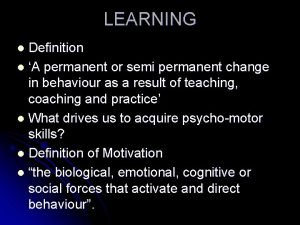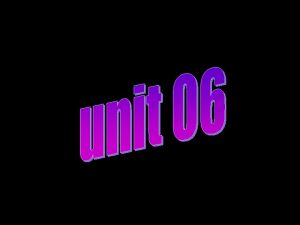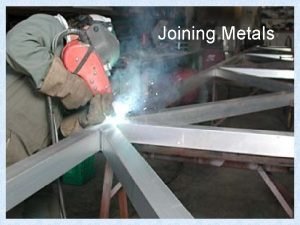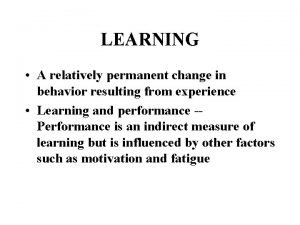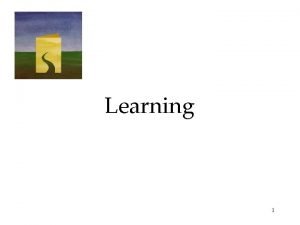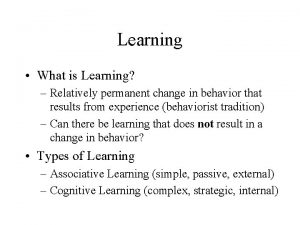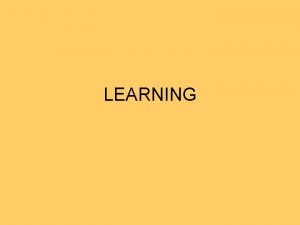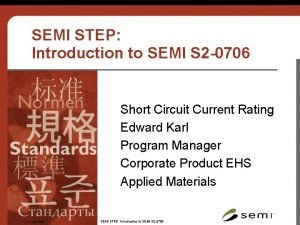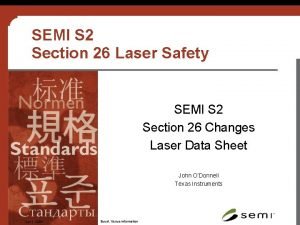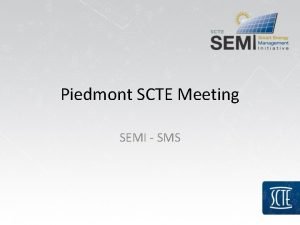LEARNING Definition l A permanent or semi permanent









- Slides: 9

LEARNING Definition l ‘A permanent or semi permanent change in behaviour as a result of teaching, coaching and practice’ l What drives us to acquire psycho-motor skills? l Definition of Motivation l “the biological, emotional, cognitive or social forces that activate and direct behaviour”. l

MOTIVATION Intrinsic: comes from within e. g. l Personal satisfaction, sense of mastery/accomplishment. Leads to self worth. Supported by extrinsic motivation but should not be replaced by. l Extrinsic: from external sources e. g. l The drive to perform to win tangible/intangible rewards l

Which type is best? l l Intrinsic ……why? Extrinsic rewards can lose their power-if you are a multi-millionaire sports performer one more prize pay packet will make little difference to you. If the focus is solely on external rewards then the enjoyment of the activity may be lost and intrinsic satisfaction will not be developed. The extrinsic reward may not be valued by the performer (another certificate!) and motivation lost.

Cognitive theories of learning Developed because of the perceived weaknesses to the conditioning theories…. such as? l 3 theories: Adams closed Loop theory, insight learning and schema theory. l Cognitive theories require the learner to understand where they are starting from and their objective (what they are trying to achieve). l

Adams’ closed loop theory Early cognitive explanation of how we learn motor skills. l Movement is initiated by a memory trace. This trace is stored in LTM and is developed from experience and external feedback. l Once started, movements are controlled by a perceptual trace. Skill learning requires the development of this trace. l

Closed Loop cont… l l The perceptual trace acts as an ongoing comparison and evaluation of the correctness of the movement. If there is a mismatch between what you are supposed to be doing (memory trace) and what you are actually doing (perceptual trace) the performer attempts to eliminate the error by changing the movement. Learning therefore becomes a process of eliminating errors. Activity

Insight Learning l l l Cognitive theories are also know as insight learning. When learner has a sudden leap of understanding and experiences a rapid improvement in learning. Relate present experience to previous similar experiences, thus involving memory. Suddenly acquiring the “knack” When everything “clicks”

Insight learning l l l E. g. a beginner rider who has learned to balance, understands steering and can keep forward motion will suddenly be able to ride a bike! A learner suddenly discovers the relationship between the many stimuli they have been faced with and it ‘all comes together!’ Linked to Gestalt Theorists who state “whole is greater than the sum of parts”. (Whilst a movement can be broken down it must be done as a whole for the learner to fully understand it).

Advantages of insight learning Allows learners to develop own strategies and routes of understanding alongside general principles. l This enables quicker learners to progress at their own rate. l Benefits for motivation and development of individual’s full potential. l Ownership of learning l
